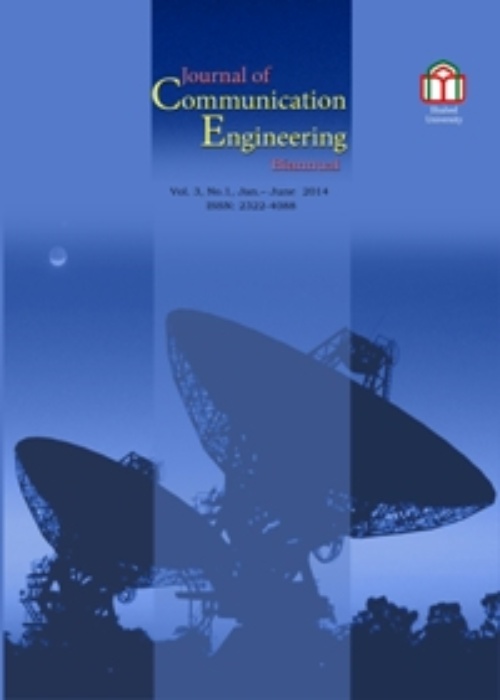فهرست مطالب

Journal of Communication Engineering
Volume:4 Issue: 1, Spring 2015
- تاریخ انتشار: 1395/02/05
- تعداد عناوین: 6
-
-
Pages 1-20From practical and theoretical viewpoints, performance analysis of communication systems by using information-theoretic results is important. In this paper, based on our previous work on Multiple Access Channel (MAC) and Multiple Access Relay Channel (MARC), we analyze the impact of a relay on the fundamental wireless communications concept, i.e., coverage region of MARC, as a basic model for uplink communications between a base station and users with the help of a relay. This analysis includes the coverage region for the MAC as a special case. Considering rate regions for the Gaussian MARC and fading Gaussian MARC, it is proved that in a fixed transmission rate, the relay extends coverage region of the MARC. Numerical illustrations confirm our theoretical results.Keywords: Multiple Access Relay Channel, Coverage region, Fixed desired transmission rates, Cellular netw
-
Pages 21-28Because of special structure, a dual reflector antenna has beam rotation capability in azimuth and elevation directions. In this structure, the antenna beam can be placed in any point in the space by mechanical movement of twist reflector which it is the most important ability of the antenna. Due to the antenna structure, if the polarization of incident wave is linear, it is expected that the polarization of propagated wave is linear and in the direction of desired design. In this paper, for the first time, a nonlinear relation is extracted that it shows the propagated beam polarization has a polarization rotation. This formula is a mathematic closed form relation. These structures are very useful in airborne radar systems.Keywords: Antenna, beam, dual reflector, feed horn, polarization, trans, reflector, twist reflector
-
Pages 29-40In this paper, we investigate the evolution of supercontinuum and femtosecond optical pulses generation through square lattice elliptical-core photonic crystal fiber (PCF) at 1550 nm by using both full-vector multipole method (M.P.M) and novel concrete algorithms: symmetric split-step Fourier (SSF) and fourth order Runge Kutta (RK4) which is an accurate method to solve the general nonlinear Schrodinger equation (GNLSE). We propose a novel square lattice PCF structure featuring a minimum anomalous group velocity dispersion (GVD), nearly zero third-order dispersion (TOD) and enhanced nonlinearity for efficient solitoneffect compression of femtosecond optical pulses and supercontinuum generation(SCG) with lowest input pulse energies over discrete distances of the fiber.Keywords: Multipole, Photonic, Soliton, Compression, Supercontinuum, Dispersion
-
Pages 41-54This work investigates the improvement of the active reflection coefficient of waveguide-fed phased-array antenna using liquid crystal layers. The anisotropic properties of liquid crystal layer can be employed to eliminate blind scan angle and improve the wide angle impedance matching of the waveguide-fed phased array antenna. The modal analysis of the waveguide-fed phased-array antenna which is covered with uniaxial anisotropic liquid crystal layers is considered. The analytical method is assumed for infinite arrays and is used to optimize the wide angle impedance matching over broad angular range of the array. The analytical results have been verified using simulation software. In this paper it is proposed to use anisotropic liquid crystal to improve the reflection coefficient of waveguide-fed phased-array antennas. Also it is proposed to employ the reconfigurable properties of liquid crystal to engineering the analytical optimization.Keywords: modal analysis, waveguide, fed phased, array antenna, liquid crystal
-
Pages 55-66in this paper we focus on the tracking performance of incremental adaptive LMS algorithm in an adaptive network. For this reason we consider the unknown weight vector to be a time varying sequence. First we analyze the performance of network in tracking a time varying weight vector and then we explain the estimation of Rayleigh fading channel through a random walk model. Closed form relations are derived for MSE, MSD and EMSE of analyzed network in tracking Rayleigh fading channel and random walk model. Comparison between theoretical and simulation results shows a perfect match and verifies performed calculations.Keywords: Distributed estimation, incremental strategies, non, stationary environment, Rayleigh fading
-
Pages 67-75This paper presents a new approach for design of the log-periodic dipole array antenna (LPDA) based on using of different design parameters in the LPDA elements to control the antenna behavior. In the proposed procedure, the design parameters can control the value of forward gain over the operating frequency range, and also adjust the gain flatness. Furthermore, this design procedure can decrease the LPDA dimensions in comparison to the conventional design. Based on the proposed design method, several LPDA antennas are designed and simulated numerically by the method of moment. The simulation results show that this LPDA design procedure can be a good candidate for design of optimized antenna in different frequency bands.Keywords: Gain control, gain flatness, log, periodic dipole array, miniaturized LPDA


